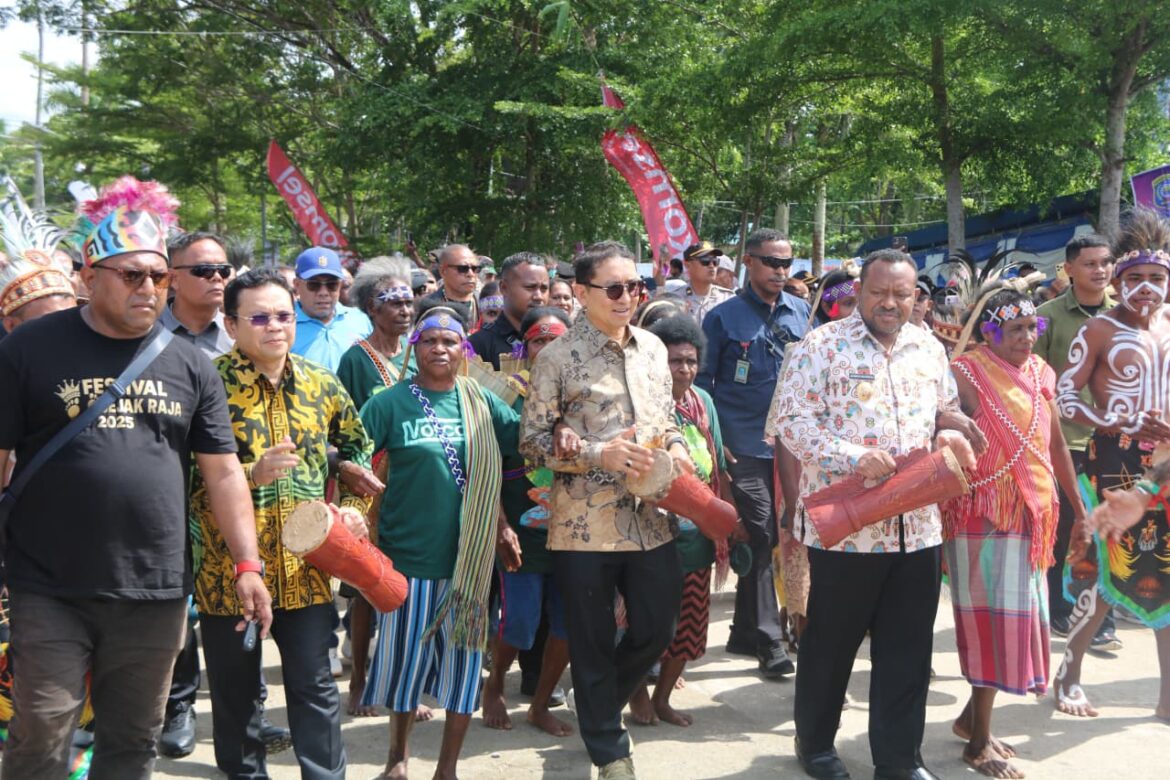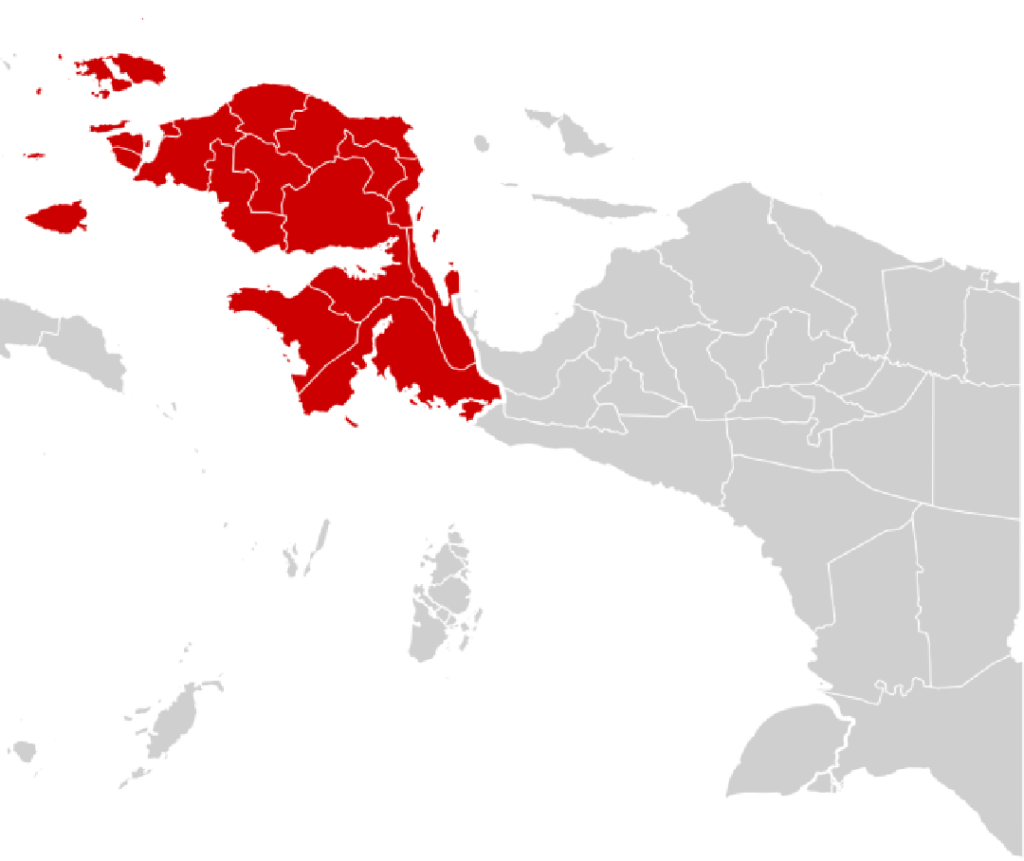The sun was barely rising over Waisai, yet the shoreline of Pantai Waisai Torang Cinta was already alive with color and rhythm. Children wore headpieces of bird-of-paradise feathers, elders carried ceremonial drums, and women prepared plates of sago and roasted fish wrapped in banana leaves. As the tide slowly receded, revealing the soft coral sands, the stage was set for something greater than a festival. The Festival Jejak Raja Pertama—the Festival of the First King—had begun.
Unlike ordinary cultural events, this festival carried a symbolic weight. It was not only about dancing, music, or exhibitions; it was about tracing the ancestral footsteps of Raja Ampat’s first kings and presenting them proudly to the nation and the world. For the people of Papua Barat and Papua Barat Daya, regions often spoken of in terms of natural resources and political tension, the festival was a chance to tell their story differently: through heritage, wisdom, and unity.
The Heartbeat of a Nation in the Drums of Raja Ampat
When Minister of Culture Fadli Zon struck the traditional drum at the opening ceremony, the sound seemed to echo off the iconic limestone karst islands that dot Raja Ampat’s waters. It was more than an act of inauguration—it was a call to remember. “Culture is the backbone of a nation. Without it, a country becomes fragile,” he reminded the crowd. His words resonated deeply because Papua, with its hundreds of languages, dances, and oral histories, represents one of Indonesia’s richest cultural frontiers.
The festival program reflected this richness. Dancers performed Wor, an ancient ceremonial dance of gratitude, moving in circular patterns that symbolize harmony. Young musicians played suling tambur, bamboo flutes, and percussion that once guided traditional rituals. Exhibitions showcased prehistoric rock paintings from Misool and Kabui, some dating back thousands of years, linking today’s communities with the earliest settlers of these islands. Food stalls offered sago, papeda, and freshly grilled fish, each bite carrying centuries of culinary memory.
For visitors who often know Raja Ampat only as a diving paradise, the festival revealed another truth: beneath the sea rich in coral and fish lies a cultural sea just as vast, equally worth exploring.
Rediscovering the Footsteps of the First King
The choice of theme—“Jejak Raja” or “Footsteps of the First King”—was deliberate. Long before Dutch colonizers arrived, before Indonesia gained independence, Raja Ampat was home to kingdoms ruled by local rajas whose influence extended across islands and seas. Their leadership was not only political but also spiritual, rooted in respect for nature and communal values. By reviving this memory, the festival honored continuity between past and present.
Local elders spoke with pride about these ancestral kings, recounting oral histories that have been passed down for generations. In a region where written records are scarce, storytelling is the archive, and festivals like this become living libraries. Each dance step, each drumbeat, and each costume carried fragments of history. Through performance, memory was kept alive.
Culture as an Engine of Tourism
The Indonesian government was clear about one of the festival’s larger purposes: to promote tourism in Papua Barat and Papua Barat Daya. For years, Raja Ampat has been internationally recognized as one of the world’s top marine tourism destinations, with its reefs designated as a UNESCO Global Geopark in 2023. Yet until now, the narrative has been dominated by its underwater beauty. The Jejak Raja Festival sought to expand that narrative by introducing culture as an equal partner to nature in shaping Raja Ampat’s identity.
As Minister Fadli Zon explained in his dialogue with local artists and officials, culture must not be seen only as heritage but also as industry. Festivals can become magnets for visitors, generating economic opportunities while safeguarding traditions. The stalls of handicrafts, weaving, and woodcarvings at the festival reflected this vision. Local artisans sold their work directly to tourists, ensuring that economic benefits flowed back to the community.
This model, officials hope, will inspire other parts of Papua to use cultural revival as a development strategy. Instead of extracting resources or building large-scale infrastructure, sustainable cultural tourism empowers communities to lead their own growth while keeping their identity intact.
Balancing Tradition, Tourism, and Conservation
Still, challenges remain. Raja Ampat is already facing pressures from rising tourist numbers, which threaten fragile marine ecosystems. Adding large cultural festivals raises questions about how to balance authenticity with commercialization. Will dances performed for tourists retain their spiritual meaning? Can rock painting sites be promoted without damaging them?
Organizers acknowledged these tensions openly. They stressed that sustainability—both cultural and ecological—must be the guiding principle. For this reason, the festival emphasized community leadership. Instead of importing performers or outsourcing management, locals shaped the program themselves. This ensured that performances stayed authentic and that rituals were not stripped of meaning.
A Living Classroom for the Next Generation
Perhaps the most moving scenes of the festival were not on the main stage but on its margins. Young Papuan children, some still in elementary school, danced alongside their grandparents. They listened intently as elders told myths of creation and migration. They tasted traditional foods prepared with ancestral techniques. For many, it was the first time they had engaged so directly with their heritage.
This intergenerational transfer of knowledge may be the festival’s greatest legacy. In an era when globalization threatens to erode local traditions, Jejak Raja became a living classroom. It reminded the youth that their identity is a source of pride, not something to hide.
National Cohesion Through Local Identity
The festival also carried meaning beyond Papua. By celebrating Raja Ampat’s culture on a national stage, the government highlighted Indonesia’s commitment to “Bhinneka Tunggal Ika”—unity in diversity. Too often, Papua is portrayed only in political or security terms. The Jejak Raja Festival challenged that narrative, showing the region as a vital contributor to Indonesia’s cultural wealth.
The presence of national officials, archaeologists, and cultural figures underscored this point. It was a reminder that Papuan traditions are not peripheral but central to the nation’s story. Festivals like Jejak Raja weave local identity into the national fabric, ensuring that diversity becomes a strength rather than a division.
Toward an Annual Tradition with Global Reach
Organizers expressed hope that the Festival Jejak Raja will become an annual event, one that grows in scale and reputation. There is even talk of linking it with international cultural circuits, inviting artists and visitors from abroad to experience the fusion of nature and culture in Raja Ampat.
With global travelers increasingly seeking authentic, sustainable experiences, the festival has strong potential to attract new markets. Imagine divers who come for the reefs staying longer to witness dances under the stars, or cultural enthusiasts visiting not only for performances but also for workshops with local artisans. In this vision, Raja Ampat could position itself as a model of integrated cultural and ecological tourism, setting an example not just for Indonesia but for the world.
The Festival’s Lasting Echo
As the final night drew to a close, torches lined the beach, casting flickering light across dancers moving in unison. The sounds of suling flutes blended with the natural orchestra of waves and wind. Above, the Milky Way arched across the sky—reminding all present that they were standing in one of the last untouched paradises on Earth.
For visitors, it was a spectacle of beauty and authenticity. For locals, it was an affirmation that their heritage matters, that their stories deserve to be told, and that their future can be built not by abandoning tradition but by embracing it. For Indonesia, it was a message: that in the footsteps of the first kings of Raja Ampat lie not only memories of the past but also blueprints for the future.
The Festival Jejak Raja Pertama proved that culture and tourism are not opposing forces but partners in development. By grounding growth in identity and by celebrating rather than commodifying heritage, Papua Barat and Papua Barat Daya have shown a path forward—one where the beat of traditional drums guides both community pride and national progress. And as the echoes of the drums faded into the night, the footprints of the first king remained, leading the way toward a future where culture, nature, and people move together in harmony.
Conclusion
The Festival Jejak Raja Pertama in Raja Ampat is more than just a cultural celebration—it is a bridge between heritage, tourism, and national identity. By reviving the footsteps of Papua’s first kings, the festival strengthens cultural pride among local communities, introduces a deeper narrative of Papua beyond its natural beauty, and promotes sustainable tourism that benefits both people and the environment. It shows that Papua Barat and Papua Barat Daya can develop by embracing their traditions, not abandoning them, and that Indonesia’s strength lies in honoring diversity as part of its unity.


